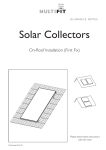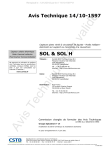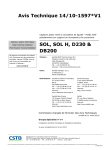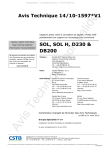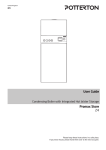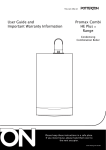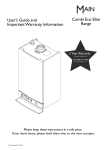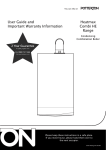Download Baxi MULTIFIT Solar Collectors Installation guide
Transcript
G U I DA N C E N OT E S Solar Collectors Installation, Commissioning & Controller Wiring Guide for East/West Array Please leave these instructions with the User © Baxi Heating UK Ltd 2011 Contents These instructions should be read in conjunction with the 1st & 2nd fix Solar Installation Guide. East West Array is perfect for roof orientations which are not south facing. The kit enables collectors to be fitted either side of the roof structure – one panel facing east and one facing west. This permits improved solar gain throughout the day. The solar controller supplied with the system pump station provides the facility built in to control an East West Array. Kits Contain: • 2m Flexible Pipe Kit • 13m Solar Sensor Wire • Cascade Module • Solar Panel Sensor • 2 x 22mm Compression Fittings • 1 Collector and appropriate Mounting Kit 2 © Baxi Heating UK Ltd 2011 1.0 Introduction to Solar 3 2.0 Installation 4 3.0 Pump and Sensor Connections 6 4.0 Commissioning the System 7 1.0 Introduction to Solar 1 2 3 4 5 6 7 8 9 10 11 12 Cold Supply for Domestic Hot Water Domestic Hot Water Outlet Auxiliary Discharge Arrangement Solar Collector 1 (West facing) Solar Collector 2 (East facing) Collector Sensor 1 (PT 1000) Collector Sensor 2 (PT 1000) Solar Pumping Station with Controller Solar Pumping Station Cascade Module Solar Expansion Vessel Auxiliary Heat Source (Central Heating Boiler) Flow Meter on a ‘COMMON’ Return (Kit) Solar Fluid is not supplied with the East West array kit. Where additional fluid is required, it must be compatible with the fluid used in the existing system. The Solar fluid must not be mixed with any other type of fluid or diluted. Failure to observe these requirements will invalidate the product warranty. Where possible all pipe runs between collectors should be as short as possible. For system controller wiring of the east west array, refer to page 6. 7 5 6 4 2 8 Blending Valve 10 3 9 East/West array kit 11 12 12 1 Combi Valve System FIg. 1 Schematic System Diagram © Baxi Heating UK Ltd 2011 3 2.0 Installation If fitting this as an extension to an existing solar system, drain the solar fluid then flush and clean the existing system. 1. Mount the east-west array cascade module in a convenient location close to the main system pump station and controller. 2. Connect the pipework as shown in Fig. 1 ensuring the outlets from both collectors form a common flow through the system pump station, and that the flow meter and return temperature sensor (if these are fitted) are mounted on a common section of the return pipe. To a suitable container 3. Fit a blanking cap to the outlet of the safety group on cascade module below the PRV, as shown in Fig. 2. Fig. 2 3 9 45° 4 4. Route a pipe from the outlet of the PRV to a suitable solar fluid catchment vessel. Air Test 5 1. An air test may be used on the pipework to detect any gross leakage prior to flushing and filling with solar heat transfer fluid. Pressurise the system to a maximum of 1 bar to check for leaks. 1 8 2. Ensure that the solar expansion vessel pre-charge pressure has been set prior to flushing and filling. 6 Flushing and Filling the pipework 6 2 6 7 Fig. 3 Read at top of float 1. Before the system is commissioned the pipework must be flushed to remove any contaminants. This must be done using the solar heat transfer fluid as it will be impossible to fully drain all parts of the system. 2. Connect the flushing pipes to the fill valve on the safety group (Fig. 3 Item 1) and to the drain valve on the flow meter (Fig. 3 Item 2) of the system pump station as shown in Fig. 4. 3. Open the fill & drain valves. 4. Turn the slot of the adjusting screws in both of the return lines (Fig. 3 Items 3 & 8) so the slot is vertical to open the nonreturn valves. Filling pump Filter 5. Close the isolating valve on the cascade module (Fig. 3 Item 9) so that the dot on thermometer bezel is at 9 o’clock position. 6. Turn the isolating valve in the flow line with integral thermometer (Fig. 3 Item 4) in the direction indicated by the arrow (to a 45° position) to open the non-return valve. 7. Ensure that the right hand isolating valve with integral thermometer in the return (Fig. 3 Item 5) is open indicated by the dot on the thermometer bezel being at the top (12 o’clock). Fig. 4 Solar fluid 8. Turn the slot of the flow meter adjusting screw (Fig. 3 Item 6) in the return vertically to open the flow limiter. 9. Flush the solar primary pump by pumping the fluid into the system via the fill valve on the safety group (Fig. 3 Item 1). 4 © Baxi Heating UK Ltd 2011 2.0 Installation 10. Close right hand isolating valve Fig. 3, Item 5 (dot on thermometer bezel at 9 o’clock position). Flush solar primary pipework and collector via the fill and drain valve on the safety group. NOTE: If reusing flushed fluid ensure this is filtered before re-introducing into the system. (see Fig.4). Use a suitable container of a large enough volume to collect the fluid. 11. Open the isolating valve on the cascade module (Fig. 3 Item 9 - dot on thermometer bezel at 12 o’clock position) and then close the isolating valve on the flow line (Fig. 3 Item 4 - dot on thermometer bezel at 9 o’clock position). Flush solar primary pipework again via the fill and drain valve on the safety group. 12. When satisfied that all pipework and component parts have been thoroughly flushed, the system can be filled. 13. Pour an amount of the solar heat transfer fluid into the filling pump. 14. Close the fill valve - safety group (Fig. 3 Item 1) and the drain valve - flow meter (Fig. 3 Item 2) and pressurise the pump slightly prior to filling the system. If an electric pump is being used follow the instructions with the pump. 15. Slowly open the fill valve on the safety group (Fig 3, item 1) and pump fluid into the system. Whilst pumping, open the flow meter drain valve (Fig 3, item 2) slightly to allow the air to vent out of the system. NOTE: When the pump is down to approximately 1 litre isolate the fill and drain valves. Vent the filling pump and refill with solar heat transfer fluid. Re-pressurise the filling pump and repeat steps 14 and 15 above until fluid is seen discharging from the drain valve on the flow meter. (Fig 3, item 2). 16. Close the drain valve. 17. Continue filling at the fill valve on the safety group (Fig 3, item 1) until the system pressure reaches 2 bar. 18. At this point the circulation pumps, air separator and any other air vents installed in the system should be vented. If the system pressure drops, repressurise using the procedure above. 19. After venting the pumps and checking that the system pressure is 2 bar, close the fill valve on the safety group (Fig. 3 Item 1), and check the system for leaks. 20.Turn the left hand isolating valve (Fig 3, item 4) back clockwise until the doton the bezel is back at 12 o’clock. 21.Turn the right hand isolating valve (Fig. 3 Item 5) back 90° clockwise until the dot on the bezel is back at 12 o’clock. 22. Turn the slot of the adjusting screws (Fig. 3 Items 3 & 8) back to the horizontal position to close the non-return valve. © Baxi Heating UK Ltd 2011 5 3.0 Pump & Sensor Connections 3.1 240 Volts Pump & Sensor Connections To Solar Controller Fuse rating T 2A L 250V Collector 1 (West facing) temperature sensor connected to terminals marked T1 (polarity free) FUSE PE PE A2 A3 A1 L T2 T1 T3 T4 T5 T6 T7 Collector 2 (East facing) temperature sensor connected to terminals marked T3 (polarity free) PE PE N N N N M1 M2 M3 Terminal Reference Description L 240V Supply Live N 240V Supply Neutral A1 Switched Output to Solar Pump N Solar Pump Neutral A2 Switched Output - Live 2 N Switched Output 2 Neutral A3 Switched Output - Live 3 N Switched Output 3 Neutral PE M5 M6 M7 Low Voltage (SELV) connections Mains 230/240V connections Fig. 5 M4 Earth Connection T1 & M1 Temperature Sensor Collector 1 T2 & M2 Temperature Sensor Storage Tank 1 T3 & M3 Temperature Sensor Collector 2/Storage Tank 2 T4 & M4 Temperature Sensor Collector Return T5 & M5 Temperature Sensor for 2nd temperature differential controller T6 & M6 Frost Protection or 2nd temperature differential controller T7 & M7 Flow Meter (Optional) Cylinder temperature sensor connected to terminals marked T2 (polarity free) System Pump circuit to Collector 1 connected to terminals marked A1 and N (240V terminals – observe polarity) Cascade Pump circuit to Collector 2 connected to terminals marked A2 and N (240V terminals – observe polarity) NOTE: Refer to the instruction manual supplied with the solar controller if the wiring layout differs from the one shown in Fig. 5. The collector temperature sensors must be installed in the relevant sensor pockets mounted on the collector and sealed using high temperature UV resistant silicone sealant. Refer to the relevant Collector Mounting Installation Guide for details of the position of the sensor pockets. Only the BLACK sleeved sensors should be used in the collector. 4.2 Setting The Solar Controller System Parameter To East West Configuration • Turn the power off to the solar controller (System Pump Station). • Turn the power back on to the solar controller (settings can only be adjusted in the first minute of powering up. • Press the right button until the spanner symbol is displayed ( ). • Reset the system parameter for the hydraulic system layout to show ‘4’ (refer to the instruction manual provided with the solar controller). • Press the right button so that the OK symbol appears. • Press the right button again to set and confirm new parameter 4 (East/West Array). 6 © Baxi Heating UK Ltd 2011 4.0 Commissioning the System For step by step guide to operate the controller, refer to commissioning instructions. Ensure collectors temperatures are cool before this process. 1 4.1 1. Turn the power to the solar controller. This should display the information screen. 2 3 5 4 Ensure the Solar Primary System is free from air 2. Key the left button (Fig. 6, item 3) once to enter the main menu screen. The ‘i’ icon will flash (See section 11 of the 2nd fix Solar manual for a description of the solar controller button functions). Fig. 6 WARNING: During this commissioning stage the safety temperature control is disabled. Ensure collectors are cool. 3. Each pump unit needs to be set up individually. 4. Press the right button (Fig. 6 item 5) twice to select the manual operation menu ( ). Press the down button and the ‘pump’ symbol and the ‘switch output 1 and 2 symbols should now be seen with a ‘zero’ displayed. Changing the ‘zero’ to a ‘one’ will operate the pump. To do this, press the right button and the ‘zero’ will flash. 5. Press either the up or down button to manually activate pump 1, then key right to accept the setting. See commissioning section to follow controller settings. 6. Leave the pump running for sufficient time to allow any residual air to be purged from the system via the air separator and any bleed points fitted to the system. Use the flow gauge window (Fig. 3, item 7) as a visible indicator of the air bubbles. NOTE: During this time the joints may be checked for leaks. 7. Stop the pump using the button procedure described previously (paragraph 4). If pressure has been lost from the system during the air bleeding process, the top up procedure described earlier can be repeated to top up the system. 8. Repeat 5 to 7 for pump 2, and select pump 2. 4.2 Setting the System Pressure a) During commissioning, the system pressure should be 0.7 bar above the static pressure (1 metre height differential equals 0.1 bar). However, it must be at least 1.5 bar and no higher than 2.2 bar. b) Determine the system pressure when the system is cold (20°C). This should be recorded on the Commissioning Record Sheet in the second fix manual. c) If the pressure is too low you should pump additional heat transfer fluid into the system; the fill valve on the safety group (Fig. 3 Item 1) needs to be opened for this purpose. When system pressure is correctly set, ensure the fill valve is closed and remove filling hose from safety group. d) Remove all tubing from the fill valve on the safety group (Fig 3, item 1) and the drain valve on the flow meter. (Fig 2, item 2) and replace both the sealing caps securely, ensuring that the rubber seals are fitted. Check for leaks. © Baxi Heating UK Ltd 2011 7 4.0 Commissioning the System 4.3 Checking and adjusting the flow rate East/West 1. Adjust the flow rate when the system is cold (20°C) (see Fig. 7). 2. The flow rate should be adjusted to give the optimum flow. 1 Open Closed 3. Manually operate the cascade pump (see section 4.1 paragraph 4). Warning: The temperature control is disabled during this procedure. 2 4. Set the cascade pump speed selector so that the required flow rate is achieved or exceeded with the lowest possible setting. The flow gauge adjusting screw (Fig. 7, item 1) can be used to fine-tune the flow rate. 5. Set the required flow rate for the collector array connected to the cascade module. Fig. 7 Read at top a) The float in the flow gauge will indicate the circulation flow rate through the flow gauge sight glass (Fig. 7, Item 2). of float Key - Item Identification 1 2 Flow Gauge Adjustment Screw (shown in open position) Flow Gauge b) Adjust screw of the flow limiter (Fig. 7, item 1) with a screwdriver, until the upper edge of the float in the sight glass indicates the required flow rate. Turn the screw anticlockwise to increase the flow. c) Ensure that the float is stable when the pump is running. No air bubbles should be observed during this procedure. d) Set manual pump operation to off (reset to zero). e) Refit the front facia moulding onto the rear moulding. 6. Manually operate System Pump 1. 7. Set the required flow rate for the collector array connected to the cascade module. a) The float in the flow gauge will indicate the circulation flow rate through the flow gauge sight glass (Fig. 7 Item 1). b) Adjust screw of the flow limiter with a screwdriver, until the upper edge of the float in the sight glass indicates the required flow rate. Turn the screw anticlockwise to increase the flow. All descriptions and illustrations provided in this leaflet have been carefully prepared but we reserve the right to make changes and improvements in our products which may affect the accuracy of the information contained in this leaflet. All goods are sold subject to our standard Conditions of Sale which are available on request. c) Ensure that the float is stable when the pump is running. No air bubbles should be observed during this procedure. d) Set manual pump operation to off (reset to zero). M U L T I F IT e) Refit the front facia moulding onto the rear moulding. A Tr a din g D i v i s i o n o f B ax i H eat i ng U K Lt d ( 3879156) Brooks House, Coventry Road, Warwick. CV34 4LL Technical Enquiries 0844 871 1568 Website www.bdrthermea.com e&oe © Baxi Heating UK Ltd 2011 UK Comp No 720862801 (4/11)









